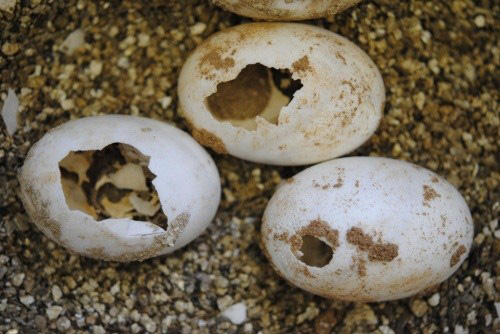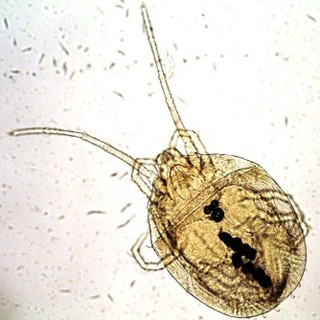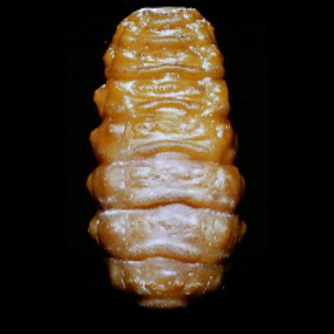
Waste from fish and poultry and fly larvae of
Lucilia sericata and
Sarcophaga carnaria were used to measure the weight reduction factor, larval yield, and bioconversion rate. Larvae of
L. sericata and
S. carnaria were efficient in reducing the mass of poultry and fish waste by 2.5-5.5-fold. The average yield of larvae reared on fish and poultry waste was approximately 304 g, while the bioconversion rate ranged between 16.6 and 39.6%. Water and undigested waste accounted for 60-77% of the larvae and pupae body mass, while protein followed by fat and carbohydrate were the most important components. Representatives of Enterobacteriaceae, Pseudomonas, Aeromonas, Micrococcus and sulfite-reducing Clostridia species were isolated from the waste products as well as from the larvae and pupae of both flies used. The total CFU g-1 counts in the various wastes, as well as in the larvae and pupae ranged from 105-109. The weights of striped bass fed with standard fish food supplemented with larvae increased slightly, when compared to those fed on standard food alone (Braverman et al. 2011).

Ranching crocodiles for their skins has been successfully implemented in several African countries but also in Israel. Recently, in one of these ranches, an increased mortality of crocodile eggs (Figure above) was observed and it was thought that insects were causing their death. Two crocodile eggs were kept together with 100 adults of
Tribolium castaneum, while the third egg was kept without beetles. No food for beetles was added to the boxes. The eggs were observed twice a month for any kind of changes on their surface. After two months, at least 39 holes were observed in one egg and 146 on the second egg, which was exposed to beetles, while no holes could be seen in the control egg. Some of the holes were deep enough to see the inner layers of the egg. There is enough evidence to believe that adults of
T. castaneum are able to damage the eggs of the Nile crocodile and in some cases lead to their death; measures should be taken to protect the eggs from this and similar species of beetles (Mumcuoglu, 2012).
Certain mites (Acarina) are parasitic on insects and other arthropods or use them as a means for transport to habitats where they find more suitable environmental conditions. This article reports on phoretic and parasitic mites collected from Diptera in Israel and Egypt. Flies from the families Muscidae, Ceratopogonidae, Sphaeroceridae, Milichiidae, Sepsidae, and Ulidiidae were collected in the periphery of cowsheds and horse stables using Williams fiberglass panel (Alsynite), Monks Wood, and DuToit suction traps. Specimens of the housefly (Musca domestica) and of the stable fly (Stomoxys calcitrans) were infested mainly by
Macrocheles muscaedomesticae, and to a lesser extent, by
Macrocheles subbadius, trombiculid larvae, and Dendrolaelaps nymphs. Most Culicoides species (Ceratopogonidae) were infested by water-mite larvae of the families Limnesiidae, Thyasidae, and Arrenuridae, as well as by larvae of the terrestrial Trombidiidae and Neotrombidiidae, whereas representatives of the remaining dipteran families were infested mainly by astigmatid, prostigmatid, and mesostigmatid mites (Mumcuoglu & Braverman, 2010).

Outbreaks of bovine ephemeral fever (BEF) occurred in Israel in 1990, 1999, and 2004. The main patterns of BEF spread were similar in the 1990 and in 1999 epidemics, and the BEF virus was probably carried in vectors transported by air streams across the Rift Valley and the Red Sea. In the 2004 outbreak, the primary focus of the disease was the southern Mediterranean coastal plain and the disease agent was apparently brought by infected mosquitoes carried from their breeding site in the Nile Delta by the south-western winds. The disease broke out under optimal ecological conditions, among a vulnerable cattle population and spread rapidly; it showed essentially a spring-summer herd incidence and terminated soon after the night average ambient temperature fell below 16◦C in late autumn. The herd incidence of the disease reached 78.4%, 97.7%, and 100% in 1990, 1999, and 2004, respectively. The highest herd incidence, morbidity, and case fatality rates were noted in dairy cattle herds in the Jordan Valley, with morbidity of 20%, 38.6%, and 22.2%, and case fatality rate among affected animals of 2%, 8.6%, and 5.4% in 1990, 1999, and 2004, respectively. The average sero-positivity to BEF in 1999 was 39.5%, which matched the morbidity rate. Comparison among the various age groups showed that the lowest morbidity rates were observed in the youngest age group, that is, heifers up to 1 year, with 3.2%, 3.6%, and 4.2% in 1990, 1999, and 2004, respectively. In heifers from 1 year to calving, the morbidity rates were 13.8%, 14.9%, and 28%, respectively, in first calvers 30.8%, 31.6%, and 28.3%, respectively, and in cows 34.3%, 35.7%, and 27.2%, respectively. All affected cattle were over the age of 3 months. It is hypothesized that mosquitoes and not Culicoides spp. are the vectors of the BEF virus in Israel (Yeruham et al. 2010).
Overall, 167 client-owned symptomatic cats, routinely accepted to the Veterinary Clinics of Tekirdag, Turkey were examined and were positive to the following pathogens:
Babesia canis canis (24%),
Babesia microti (2.4%),
Hepatozoon felis (10.8%),
Cytauxzoon felis (6.6%),
Bartonella henselae (40.1%),
Anaplasma platys (30.5%),
Anaplasma phagocytophilum (7.2%),
Rickettsia felis (26.3%),
Borrelia burgdorferi (21%), and hemotropic
Mycoplasma sp. (11.4%). There was a statistical difference between the gender of the cats in terms of the prevalence of all pathogens considered together, where the female cats showed a higher prevalence. This was not the case for the different age groups. The lowest infection was observed for B. microti (p<0.001), while the highest infection was observed for B. henselae (p<0.01).
Leishmania donovani, Plasmodium spp.,
Ehrlichia chaffeensis, and
Neoehrlichia mikurensis PCR test results were negative in all samples (Muz et al. 2021).
It is with deep sadness that we acknowledge the passing on April 17, 2023, in Tel Aviv, Israel, of Prof. Rachel Galun, a highly respected figure in medical, veterinary, and agricultural entomology. Prof. Galun made significant contributions to the study of medically relevant insects and ticks during her illustrious career. Her research expanded our understanding of vector-borne diseases and provided valuable insights into the interactions between these arthropods and the pathogens they transmit. This particular expertise demonstrated Prof. Galun's dedication to tackling intricate problems at the intersection of biology and public health in an objective manner. She researched the mechanisms behind mosquitoes' ability to identify the blood of their hosts by identifying ATP in said blood. Furthermore, she explored how ticks are induced to feed on blood by sensing glutathione in the blood, which triggers stimulation in their chelicerae's sensillae. Additionally, Prof. Galun demonstrated the capability of tsetse flies and mosquitoes to inhibit the host's local immune response for blood-feeding purposes. Her research included the development of artificial feeding methods to study sensory responses in insects, particularly mosquitoes (Mumcuoglu, 2023).
In a latrine in Qumran (First Century BCA) soil samples were collected and examined by flotation technique. The eggs of
Ascaris sp.,
Taenia sp., and
Trichuris sp. were identified (Harter et al. 2005).
The importance of insect and mites in forensic veterinary medicine has been underlined in a review article (Taylan Özkan & Mumcuoglu, 2023).
Website
Since 2016, KYM is the webmaster of the “Israel Society for Parasitology, Protozoology and Tropical Diseases”
website.
References
Braverman, Y., U. Marchaim, L. Glatman, V. Drabkin, A. Chizov-Ginzburg, K. Y. Mumcuoglu & A. Gelma. 2011. Bioconversion of poultry and fish waste by Lucilia sericata and Sarcophaga carnaria larvae. Asian J. Water Environ. Pollut. 8: 69-75.
Harter S, Bouchet F, Mumcuoglu KY, Zias JE. 2005. Toilet practices among members of the Essene Sect at Qumran (100 BC–68 AD). Review de Qumran 84: 579-584.
Mumcuoglu, K.Y. 2012. Mortality of Nile crocodile (Crocodylus niloticus) eggs caused by the floor beetle (Tribolium castaneum). Open J. Vet. Med. 2: 9-12.
Mumcuoglu KY. 2023. Rachel Galun (1926-2023). Isr J Entomol. 52: 9-19.
Mumcuoglu, KY. & Y. Braverman. 2010. Parasitic and phoretic mites of Diptera in Israel and the Sinai Peninsula, Egypt. Isr. J. Entomol. 40: 195-203.
Muz MN, Erat S, Mumcuoglu KY. 2021. Protozoan and microbial pathogens of house cats in the Province of Tekirdag in Western Turkey. Pathogens. 2021 Aug 31;10(9):1114. doi: 10.3390/pathogens10091114.173
Taylan Özkan A, Mumcuoglu KY. 2023. Veterinary Forensic Entomology (in Turkish). In: Veterinary Forensic Medicine. Yıldız G, Hancı IH (eds.). Seçkin Yayınevi, Ankara, pp. 49-68.
Yeruham, I., M. Van Ham, Y. Stram, O. Friedgut, H. Yadin, K.Y. Mumcuoglu & Y. Braverman.2010. Epidemiological investigation of bovine ephemeral fever outbreaks in Israel. Vet. Med. Intern. Vol. 2010 (2010), Article ID 290541, 5 pages. doi:10.4061/2010/290541.

